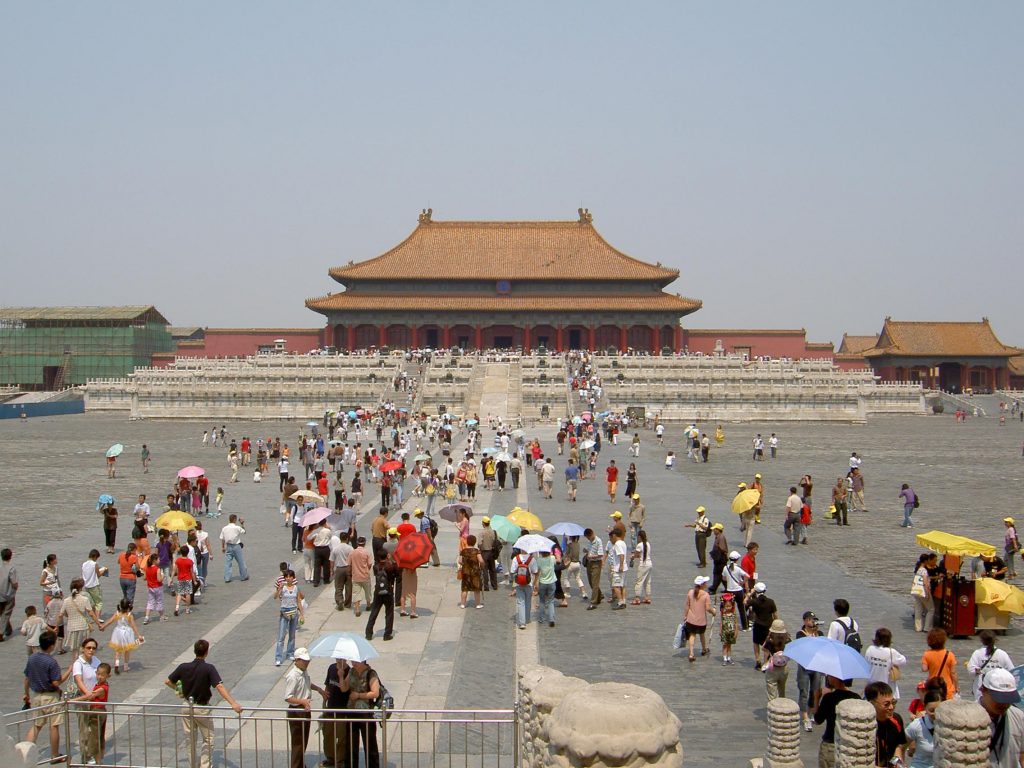Its been a mixed time in Beijing. In the first couple of days the glasses I bought in Hong Kong broke, followed by my camera a day later. Much time was spent in trying to get them repaired in local stores but in neither case was I successful.
Unfortunately the camera broke on the nicest day I had in Beijing, with a clear blue sky, sunshine and cooler fresher air. I had planned to see the Forbidden City and had just started at the south of Tiananmen Square when the misfortune occured. I did get to the Forbidden City a couple of days later and was disappointed. It suffered from the fundamental problem that exists in Chinese museums: a lack of information and explanation. There are very few explanation boards, you have to pay two thirds the cost of an already expensive ticket to hire the audio tour, any maps or leaflets are extra and you have to pay more to enter some of the exhibitions contained within. In addition being at the heart of a large city and extremely populous nation it is very busy. I headed through from south to north, taking a quieter route up the east side of the compound.




To the north of the FC is Jingshan Gongyuan, a park with hills built from the earth and rock excavated from the FC’s moat and the remains of the old palace the FC was built on top of. This was much better as from the top of the highest peak you can look over the Forbidden city as a whole and I found this more impressive than being inside it. As the FC is a large collection of fairly low buildings with limited open spaces you get little idea of the overall scale when inside. From the peak you could see its total extent.


The Great Wall does live up to its name and reputation. I headed for one of the quiter and more dramatic spots at Simatai. Here the wall traces a course along the crest of the hills and then down the sides of a valley as it plunges towards a river. Some slopes have a 70 degree incline and the views are amazing. The volume of work it must have taken to build this entire affair is staggering when you conside the height, width & length of the wall (several thousand km) as well as all the towers along its length and the terrain on which much of it is built. From a pragmatic point of view I can’t help feeling a series of forts would have been easier to build and afforded better defence but that would not have left us with this incredible wonder of the world.



Having mainly travelled through the cities you I cannot help to have noticed how fast China is developing. There is a lot of traffic with many of the cars being new and expensive, there are a large number of buildings being developed and there are shopping malls with luxury goods everywhere. This is all for a small percentage of China’s population and the bulk of its over 1 billion population will be looking to catch up. This has huge implications for the world as a whole and here are a few to prompt thought :
- If car ownership in China reaches the same level as currently exists in the USA there will be more cars in China than currently exist in the world.
- A factory employee in China is often paid less than $100 US per month. As China has 900 million people in the poor rural economy if every manufacturing job in the US and Europe moved to China it would have people to spare.
You can see why global companies are so eager to have a presence in China as it offers both a staggering marketplace for products and a very cheap labour force. The pace of modernisation in China is rapid in the cities, though I expect much slower in the countryside. In some ways the country hasn’t changed. The BBC News website is banned from Chinese internet, as are satellite dishes for the general population. It must be the only country in Asia where most dwellings don’t have a dish pointing upwards. I don’t know how the Chinese population in general feel about Mao but his Mausoleum still sits in Tiananmen Square and his portrait in the centre of Tiananmen Gate. This being the man that drove the Great Leap Forward resulting in death of 30 to 60 million people from famine and later inspired the Cultural Revolution where students attempted to destroy China’s education system, arts and ancient culture. It is probably because the history section of Lonely Planet’s China guide makes this clear that it is not available in this country whilst LP’s for other countries are.
China has been an interesting place to visit but hard work and lonely. If / when I return here I won’t travel alone. Tomorrow morning my father arrives in Beijing and on the next day we catch our train to Moscow. I doubt I will be back on the internet before then. Until then I am off to buy supplies for our week on the train.
